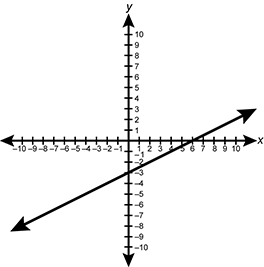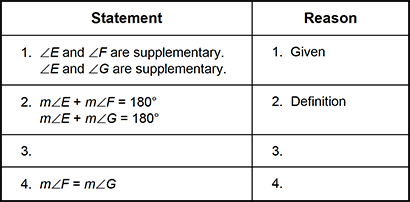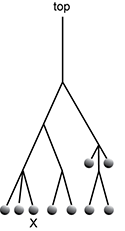Study Guide
Field 034: Middle School Mathematics
Sample Multiple-Choice Questions
Objective 0001
Number and Quantity (Standard 1)
1. During a class discussion about mental math techniques, a student presents the following method of multiplying 5 × 24:
5 × 24 = 5 × (4 × 6) = (5 × 4) × 6 = 20 × 6 = 120
The student's method is based on which of the following number properties?
- distributive
- associative
- symmetric
- commutative
- Answer
- Correct Response: B.
This question requires the examinee to demonstrate knowledge of the properties of real and complex numbers and their subsets. The associative property of multiplication states that numbers being multiplied can be grouped and multiplied in a variety of ways without affecting the product. The student uses this property of multiplication to simplify the calculations involved in finding the product of 5 × 24.
Objective 0001
Number and Quantity (Standard 1)
2. Use the list of instructions below to answer the question that follows.
1. Add 9 and 6.
2. Multiply by 2.
3. Subtract 12.
4. Divide by the square of 3.
Which of the following expressions represents the sequence of instructions shown?
- 9 + 6 × 2 – 12 ÷ 32
- [2(9 + 6) – 12] ÷ (3 × 3)
- [2(9 + 6) – 12] ÷ 3 × 3
- (9 + 6 × 2 – 12) ÷ 32
- Answer
- Correct Response: B.
This question requires the examinee to demonstrate knowledge of interpreting numerical expressions and applying the order of operations. Arithmetic operations on integers are performed in the following sequence: operations inside parentheses first, followed by exponentiation, then multiplication/division, and addition/subtraction. Note that division is considered multiplication by a fraction, and subtraction is addition of a negative number. In this case the sequence of operations yields [2(9+6) –12] ÷ (3 × 3), then [2(15) –12] ÷ (9), then [30 –12] ÷ (9) to [18] ÷ (9) to 2.
Objective 0001
Number and Quantity (Standard 1)
3. Use the number line below to answer the question that follows.

On the number line, the coordinate of A is  and the coordinate of B is
and the coordinate of B is  . If the distance from A to C is twice the distance from C to B, what is the coordinate of C?
. If the distance from A to C is twice the distance from C to B, what is the coordinate of C?
- Answer
- Correct Response: D.
This question requires the examinee to demonstrate knowledge of computational fluency with rational numbers. The distance B – A = . The distance from A to C is given as twice that of C to B, so the distance of C to B is one-third of the distance from A to B, which is
. The distance from A to C is given as twice that of C to B, so the distance of C to B is one-third of the distance from A to B, which is  . Thus distance of C to B =
. Thus distance of C to B =  , and the coordinate of C can be calculated as B – C, or
, and the coordinate of C can be calculated as B – C, or  .
.
Objective 0001
Number and Quantity (Standard 1)
4. The members of a family collect their loose change in a large jar. At the start of a certain year, they have $50 in the jar. From this point, their change collection grows at the rate of 100% per year. After 5 years, what is the total percent of increase in the value of the change in the jar?
- 500%
- 1500%
- 2300%
- 3100%
- Answer
- Correct Response: D.
This question requires the examinee to demonstrate the ability to apply knowledge of ratio concepts and proportional reasoning to solve problems. If the initial $50 increases at a rate of 100% per year, the amount doubles each year and there will be $1600 after 5 years. The percent increase in the value of the change in the jar during the five year period can be calculated as .
.
Objective 0002
Algebra (Standard 2)
5. In September, a store advertised scientific calculators for $15 each and graphing calculators for $79 each. Calculator sales totaled $2530, with 12 more scientific calculators sold than graphing calculators. If x represents the number of scientific calculators sold, which of the following equations models this situation?
- 15x + 79(x + 12) = 2530
- 15(x + 12) + 79x = 2530
- 15x + 79(x – 12) = 2530
- 15(x – 12) + 79x = 2530
- Answer
- Correct Response: C.
This question requires the examinee to demonstrate knowledge of the modeling of real-life problems using numeric and algebraic expressions and equations. The total sales of each type of calculator can be expressed as the product of the price of the calculator and the number of calculators sold. If x represents the number of scientific calculators sold, and x – 12 the number of graphing calculators sold, the total sales of both types of calculators can be expressed as15x + 79(x – 12) = 2530.
Objective 0002
Algebra (Standard 2)
6. Use the graph below to answer the question that follows.

What is the x-coordinate of the point where the graph of the line 3x + 6y = 6 intersects the line shown?
- –2
- 0
- 2
- 4
- Answer
- Correct Response: D.
This question requires the examinee to demonstrate knowledge of graphical representations of equations. The x-coordinate of the point where the two lines intersect can be determined by solving a system of equations representing the two lines. Line 3x + 6y = 6 can be written in y = mx + b form and simplified to . The equation of the line shown on the graph can be determined from its x- and y- intercepts, (6, 0) and (0, –3): the slope of the line is
. The equation of the line shown on the graph can be determined from its x- and y- intercepts, (6, 0) and (0, –3): the slope of the line is  , so
, so  . Setting
. Setting  equal to
equal to  yields x = 4.
yields x = 4.
Objective 0002
Algebra (Standard 2)
7. Which of the following intervals is the solution to the inequality 2 | x + 3 | – 1 ≥ 0?
- x ≤ –3.5 or x ≥ –2.5
- x ≥ –3.5 or x ≤ –2.5
- x ≥ 3.5 or x ≤ 2.5
- x ≤ –3 or x ≥ –2
- Answer
- Correct Response: A.
This question requires the examinee to demonstrate knowledge of solving one-variable inequalities. The first step in solving this absolute value inequality is to isolate the absolute value expression on one side of the inequality as follows: | x + 3 | ≥ . There will be two possible solutions, depending on whether the expression inside the absolute value symbol is positive or negative: x + 3 ≥
. There will be two possible solutions, depending on whether the expression inside the absolute value symbol is positive or negative: x + 3 ≥  gives x ≥ –2.5 and x + 3 ≤ –
gives x ≥ –2.5 and x + 3 ≤ – gives x ≤ –3.5.
gives x ≤ –3.5.
Objective 0003
Functions (Standard 3)
8. The graph of y = 2x is reflected first over the y-axis and then over the x-axis. Which of the following equations represents the final graph?
- y = –2–x
- y = 2–x
- y = 2x
- y = –2x
- Answer
- Correct Response: A.
This question requires the examinee to demonstrate knowledge of the manipulation of functions, including transformations. When the graph of y = 2x is reflected over the y-axis, the y values of the new function are calculated as the values of the original function when –x is substituted for x, or y = 2–x. When this function is then reflected over the x-axis, every y-coordinate will have a value that is the negative value of the original y, or y = –2–x.
Objective 0003
Functions (Standard 3)
9. If dn represents the number of diagonals that can be drawn in an n-sided polygon, then dn+1 = dn + (n – 1) represents the number of diagonals that can be drawn in an (n + 1)-sided polygon. If a 10-sided polygon contains 35 diagonals, how many diagonals are contained in a 13-sided polygon?
- 65
- 68
- 77
- 81
- Answer
- Correct Response: A.
This question requires the examinee to demonstrate knowledge of extending a variety of patterns and representing them algebraically. A table of the number of sides and diagonals in polygons can be produced by substituting values for dn and n into the given equation, dn+1 = dn + (n – 1). For example, d11 = d10 + 9 = 35 + 9 = 44.

Alternatively, the number of diagonals in an n-sided polygon can be determined using the formula, number of diagonals = .
.
Objective 0004
Measurement and Geometry (Standard 4)
10. Two mathematics teachers would like to find the area of their school's oddly shaped parking lot. They drive a car around the lot and discover that its perimeter is 0.35 km. Using this information, one teacher estimates the parking lot's area by assuming that the lot is shaped like a circle, while the other teacher assumes that it is shaped like a square. What is the approximate difference between the two estimates?
- 21 m2
- 210 m2
- 2,100 m2
- 21,000 m2
- Answer
- Correct Response: C.
This question requires the examinee to demonstrate knowledge of the application of length, perimeter, and area formulas of basic geometric figures. Assume that the parking lot is a circle with perimeter of 0.35 km = 350 meters. The circumference of the circle can be calculated as 2 r = 350, so the radius of the circle is
r = 350, so the radius of the circle is  . The area can be calculated as
. The area can be calculated as  . If the parking lot is considered a square of perimeter
. If the parking lot is considered a square of perimeter 350 m , then the length of a side, s, is and the area is s2, or 87.52 = 7656.25 m2. The difference between the two estimates is 9748.24 – 7656.25 ≈ 2091.99 or 2,100 m2.
and the area is s2, or 87.52 = 7656.25 m2. The difference between the two estimates is 9748.24 – 7656.25 ≈ 2091.99 or 2,100 m2.
Objective 0004
Measurement and Geometry (Standard 4)
11. Point M is located on the x-axis and is distance d away from point P on the y-axis. If P is at distance  from the origin, which of the following expressions represents a possible x-coordinate for point M?
from the origin, which of the following expressions represents a possible x-coordinate for point M?
- Answer
- Correct Response: C.
This question requires the examinee to demonstrate knowledge of the Pythagorean theorem. The triangle consisting of point M, point P, and the origin is a right triangle. The lengths of the hypotenuse and one side of the right triangle are given as algebraic expressions, d and , and the length of the third side is unknown. The Pythagorean theorem, a2 + b2 = c2, can be used to determine the length of the third side, the distance, x, of point M from the origin. Here,
, and the length of the third side is unknown. The Pythagorean theorem, a2 + b2 = c2, can be used to determine the length of the third side, the distance, x, of point M from the origin. Here,  , so
, so  .
.
Objective 0004
Measurement and Geometry (Standard 4)
12. Use the incomplete proof below to answer the question that follows.
Given: ∠E and ∠F are supplementary; ∠E and ∠G are supplementary.
Prove: m∠F = m∠G

Which of the following statements could be used in step 3 of the proof?
- m∠E ≠ m∠F and m∠E ≠ m∠G
- 0° < m∠E < 180°
- m∠F + m∠G = 360° – 2m∠E
- m∠E + m∠F = m∠E + m∠G
- Answer
- Correct Response: D.
This question requires the examinee to demonstrate knowledge of reasoning and proof in Euclidean geometry. In statement 2 of the proof, it is given that the sum of m∠E and m∠F equals 180° and the sum m∠E and m∠G equals 180°. By the transitive property of equality, the two separate equations can be rewritten asm∠E + m∠F = m∠E + m∠G.
Objective 0005
Statistics and Probability (Standard 5)
13. Administrators at a middle school are considering changes to the current school busing system. Which of the following surveys would be most likely to provide reliable information about how well the current system is serving the school?
- an online poll of parents/guardians of all students in the school
- an e-mail asking parents/guardians of students currently using the school buses to respond
- a survey that contacts a parent/guardian for every tenth student listed in the school registry
- a poll of all parents/guardians attending a regularly scheduled meeting of a parent-teacher association
- Answer
- Correct Response: C.
This question requires the examinee to demonstrate knowledge of sampling, bias, and randomization. The survey that will provide the most reliable information is the one that will generate unbiased data. In order for the survey to be unbiased, the population being surveyed should be representative of the entire school population. The systematic sampling approach described here, in which a parent/guardian for every tenth student listed in the school registry is surveyed, is the most unbiased approach to generating the desired information about the busing system, because it doesn't automatically exclude any families from the survey.
Objective 0005
Statistics and Probability (Standard 5)
14. Use the diagram below to answer the question that follows.

The diagram represents a game in which marbles are placed at the top of an inclined board and then roll down until they fall into one of the holes. If 72 marbles roll down the board, and the direction a marble takes at each intersection is random, how many marbles will end up falling through the hole marked X?
- 4
- 6
- 8
- 9
- Answer
- Correct Response: B.
This question requires the examinee to demonstrate knowledge of simple, compound, and conditional probabilities. The probability that a marble will fall into the hole marked X can be calculated by multiplying the probabilities of the marble rolling in the direction of hole X at each fork in the path. The probability of the marble rolling in the direction of hole X at the first fork in the path is . At the second fork in the path it is also
. At the second fork in the path it is also  . The probability of the marble rolling in the direction of hole X at the third fork in the path is
. The probability of the marble rolling in the direction of hole X at the third fork in the path is  . The product of the three probabilities is
. The product of the three probabilities is  . Thus
. Thus  of the 72 marbles are expected to fall into hole X.
of the 72 marbles are expected to fall into hole X.
Objective 0006
Middle School Mathematics Instruction and Assessment (Standard 6)
15. Which of the following activities would best develop an eighth-grade student's understanding of similarity with two-dimensional figures?
- describing a sequence of rotations, reflections, translations, and dilations that transform one figure into another
- identifying the features that are common to all convex equilateral polygons with a given number of sides
- discovering that in a right triangle with a known interior angle, if one side length is known, the other side lengths can be calculated
- recognizing the characteristics common to all isosceles and special right triangles and using them to solve problems
- Answer
- Correct Response: A.
This question requires the examinee to demonstrate knowledge of instructional strategies for promoting student understanding of concepts related to mathematics. Similar two-dimensional figures have congruent corresponding angles and corresponding sides that are proportional in length. Knowledge of how to transform two-dimensional figures using dilations of various known scales will strengthen the student's ability to recognize as similar geometric figures whose corresponding sides are proportional in length.








